#entari
Explore tagged Tumblr posts
Text
Eclipse Coronation Ottoman
At the start of the reign of Gabriel III and Sonja III, I made them a promise. During their reign, in honor and imitation of all the fancy and beautiful clothing they produce, I would cut into a fabric that scared me and attempt to make something wearable.
Prior to Pennsic, my lovely wife picked up some garb for us at a SCA yard sale. this included the following rust/gold ghawazee that a local of mine (recently laurel) informed me is about 200-300 years post period, but would be an OK time saver for garbing myself up for Pennsic. With that knowledge safe in hand, I planned and started to sew a gomlek, with the intention of creating a single-layer supportive undergarment to reduce the number of layers worn on hot afternoons at pennsic. This would be my first ever supportive garment! As you can see in the following photos, the supportive garment was a success.


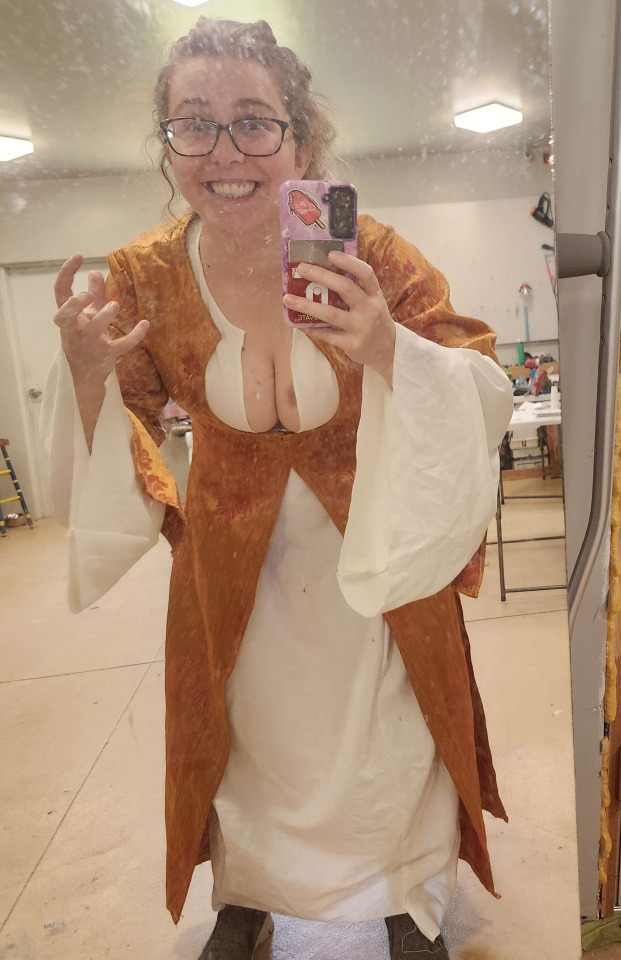
I began my research with Ottoman Turkish Garb, An Overview of Women's Clothing by Baroness Katja Davidova Orlova Khazarina. This document was recommended to me by Baroness Dominique Michelle le Vasseur. With a bit more of an idea of what I was doing (but only a bit, I was roaring full speed ahead) I used the gomlek pattern found on Turkish Costume by Vanessa Giddings. I made the gomlek from a light-medium weight white linen from stash. I serged each edge of the pieces before pinning together to prevent fraying and to buy me some time to properly finish the seams when I got home from pennsic.
Notably, this is where I made my first mistake. After making the gomlek, I decided to attempt to make it supportive just in case I didn't finish a zibin before pennsic (reader-- she didn't finish the zibin). After making the gomlek according to the Giddings pattern, I then pinched and pinned along the seam between the front body and the front gore to force a little more lift and create a "shelf" on which the breasts could rest. Because I made t his supportive, I'm glad I used a just shy of medium weight linen rather than a more appropriate looser weave, because it gave the garment the body to support the breasts.
As I was in the last leg of time crunch before Pennsic, I wanted this linen to relax as much as it was going to as fast as possible. So i threw on the gomlek, some leggings, and a lazy turban, then did some intense yard work for ~2 hours. My breasts never moved from their assigned seats, the garment relaxed comfortably, and I could move just fine in it. I then finished the gomlek off with a quick button loop and faux-pearl headed button at the neckline, though it has no structural purpose due to how I altered the garment.
With a heart full of ambition and a head empty of reason, I attacked a plan to finish a brand new entari, zibin, and an extra gomlek prior to pennsic. I accomplished none of that.
The following picture shows how I wore this for Pennsic: Gomlek, the post-period ghawazee, lazy turban, some shalwar off amazon recommended by Viscountess Caterina Giovanni, my apprentice belt, and some Rus boots as I was advised to wear ankle support in the Bog.
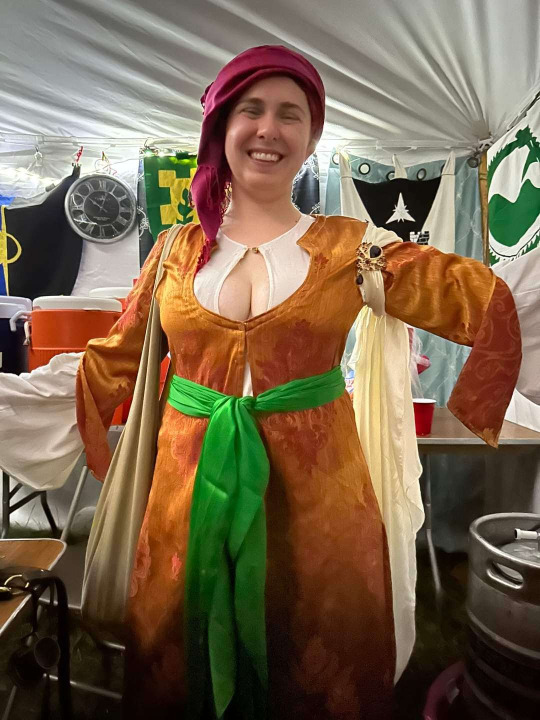
Upon my return home, I started planning the Entari, with the goal of having a gomlek and entari to wear to Namron Protectorate for Domi's laurel elevation (reader-- she didn't finish any of it in time). I selected from stash a black cotton for the lining and a red and rust upholstery fabric for the outer layer. This was chosen for the similarity, to my eye, between the repeating pattern in the stripes on the upholstery fabric and the patterns present on some extant entaris and in court portraiture. ORIGINALLY I had selected a bright blue silk i was certain I had in stash but my box o' saris was nowhere to be found.
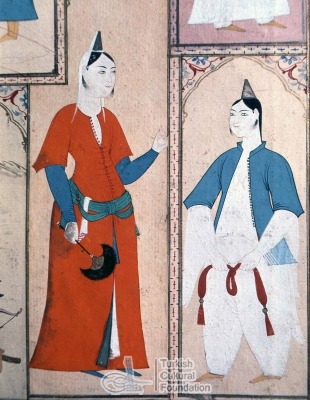
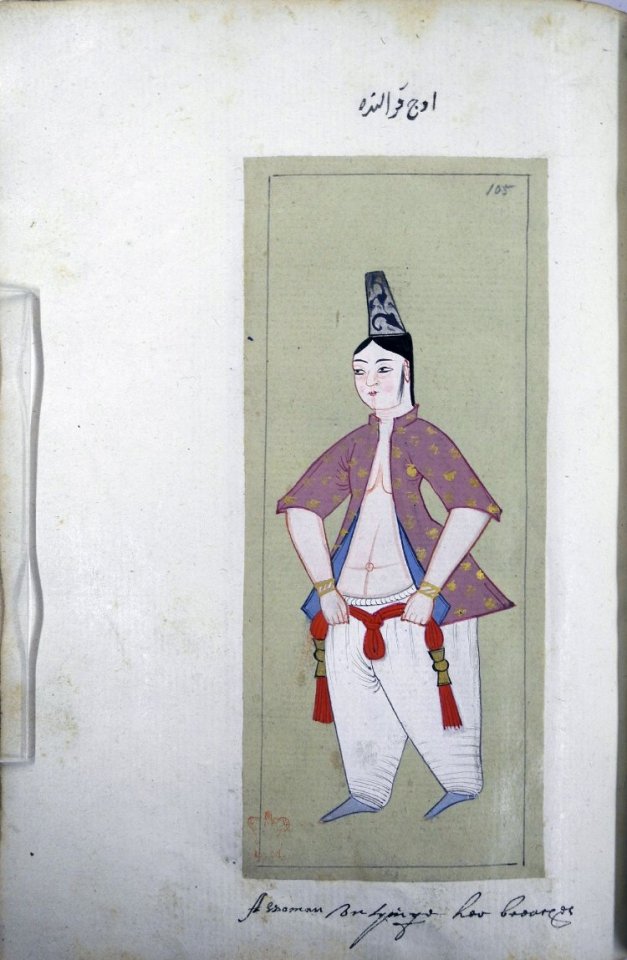

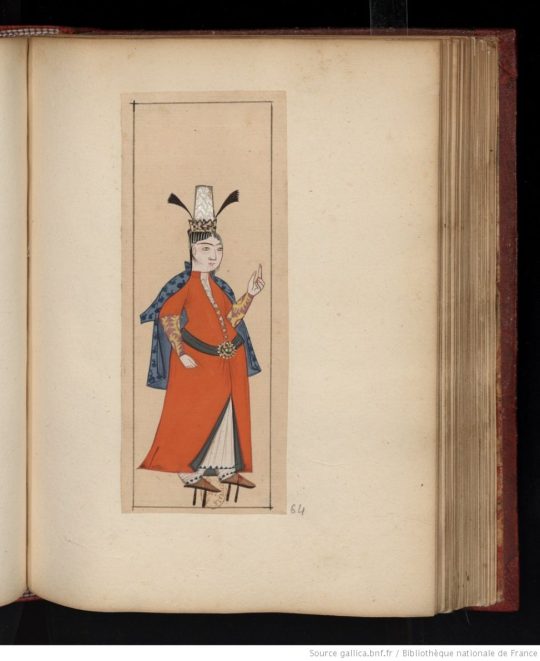
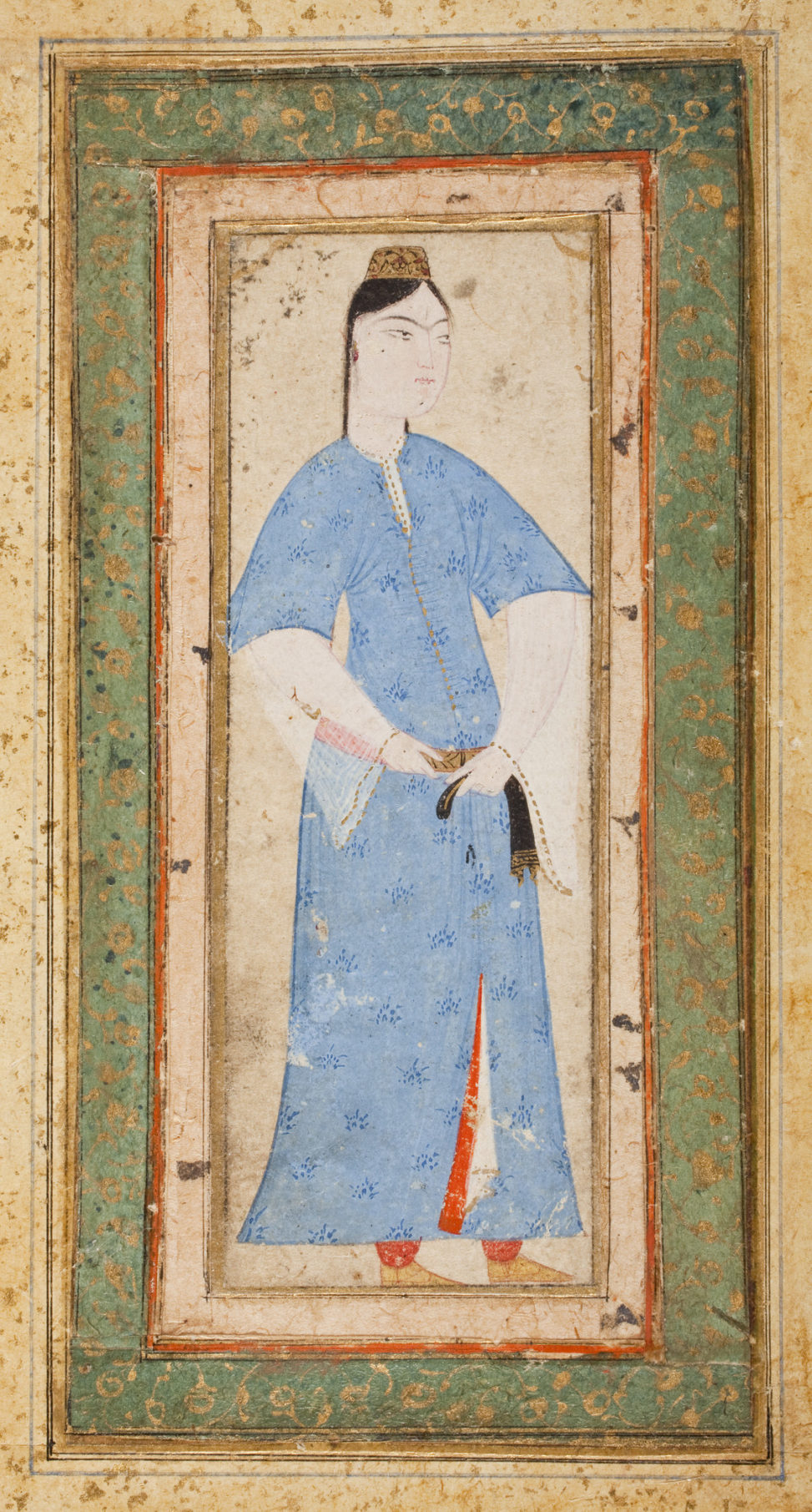
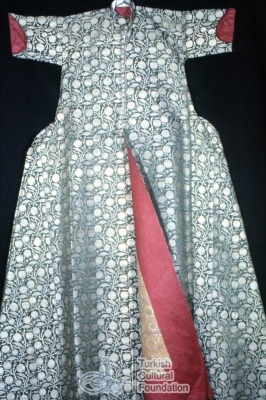
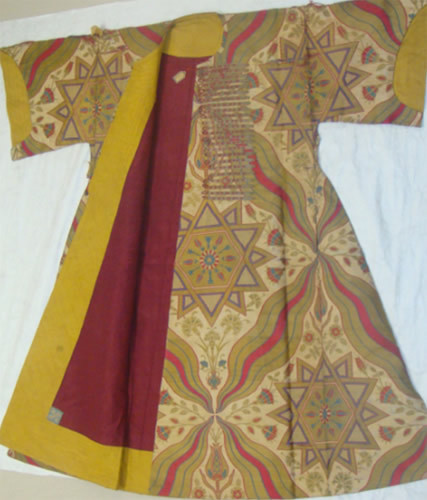
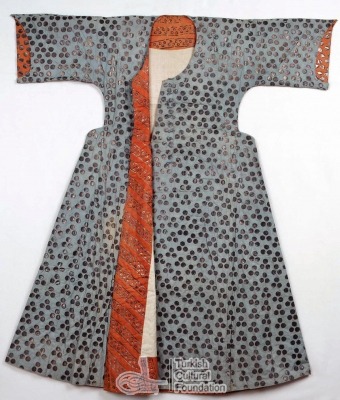
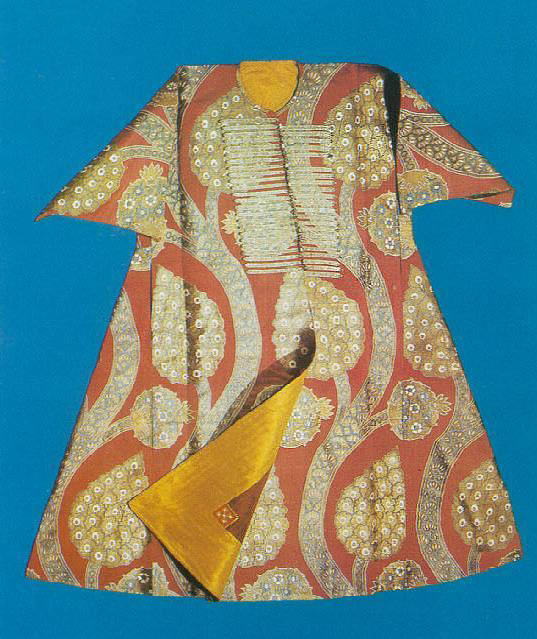
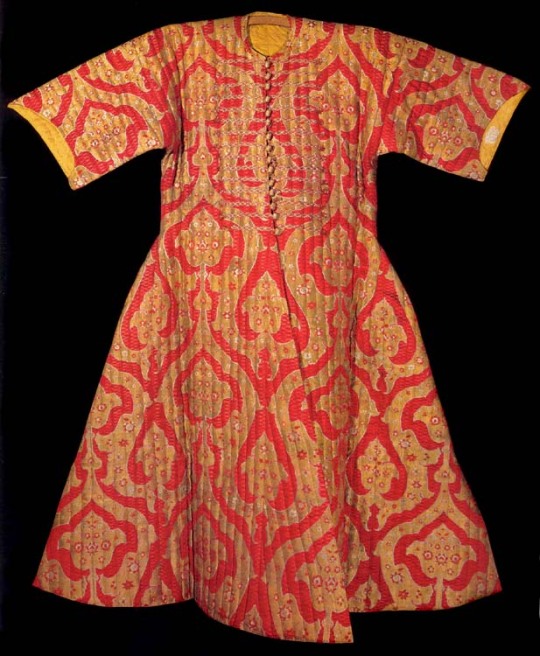
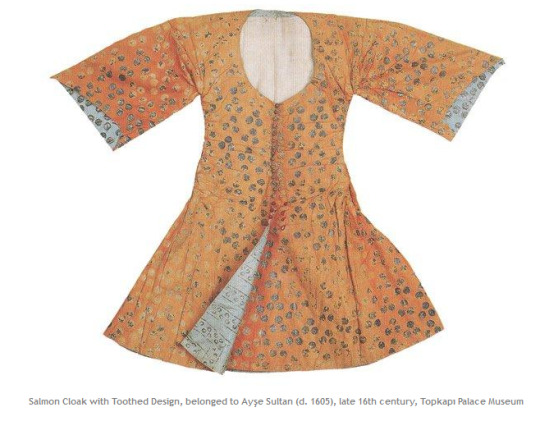
The above portraits, miniatures, and extants were accessed through the Ottoman Turkish Garment Database. The prevalence of red / blue color combos in the portraits and extants, as well as vibrant colors across the board, inspired my choices. As you can see in each of the extants as well as the art, the inside edge of the garment is faced in a color different from the lining and the outer layer. In many of the portraits, the bottom edge of the garment is turned out as if caught in motion, displaying this vibrant facing. The entaris come in different lengths but tend to be in the knee to floor range, while a hip to knee length undergarment appears to be worn as a middle layer.
The center bottom quilted kaftan in red and gold (belonging to Selim I, garment c. 1512-1520) inspired my choice of fabric, as seen below.

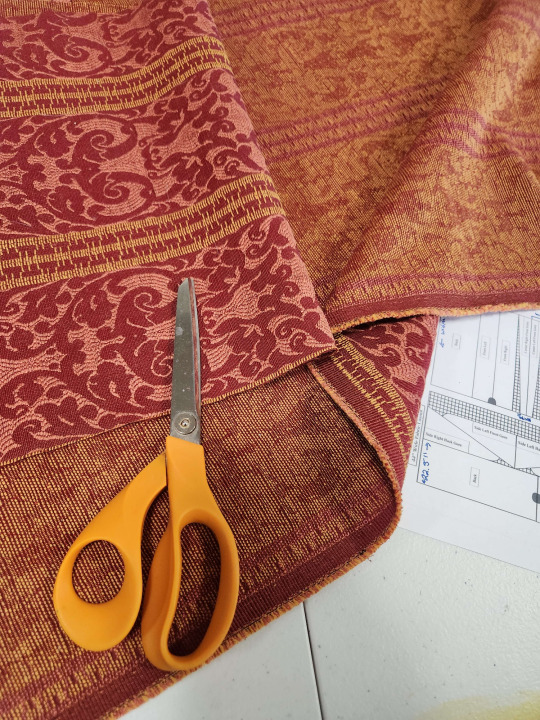
Fabric selected, then began the cutting. I used the pattern, cutting diagram, and notes from Kelebek's Persian and Turkish Clothes and drafted out onto my lining layer. Because the gomlek worked up so easily, I just used the black cotton liner as my muslin for this garment. As seen below, it fit pretty well from the outset and the notes and diagrams proved helpful in making sure everything lined up right. Gores are my nightmare. Seen below, the garment as it stood had REALLY prominent hip bumps.
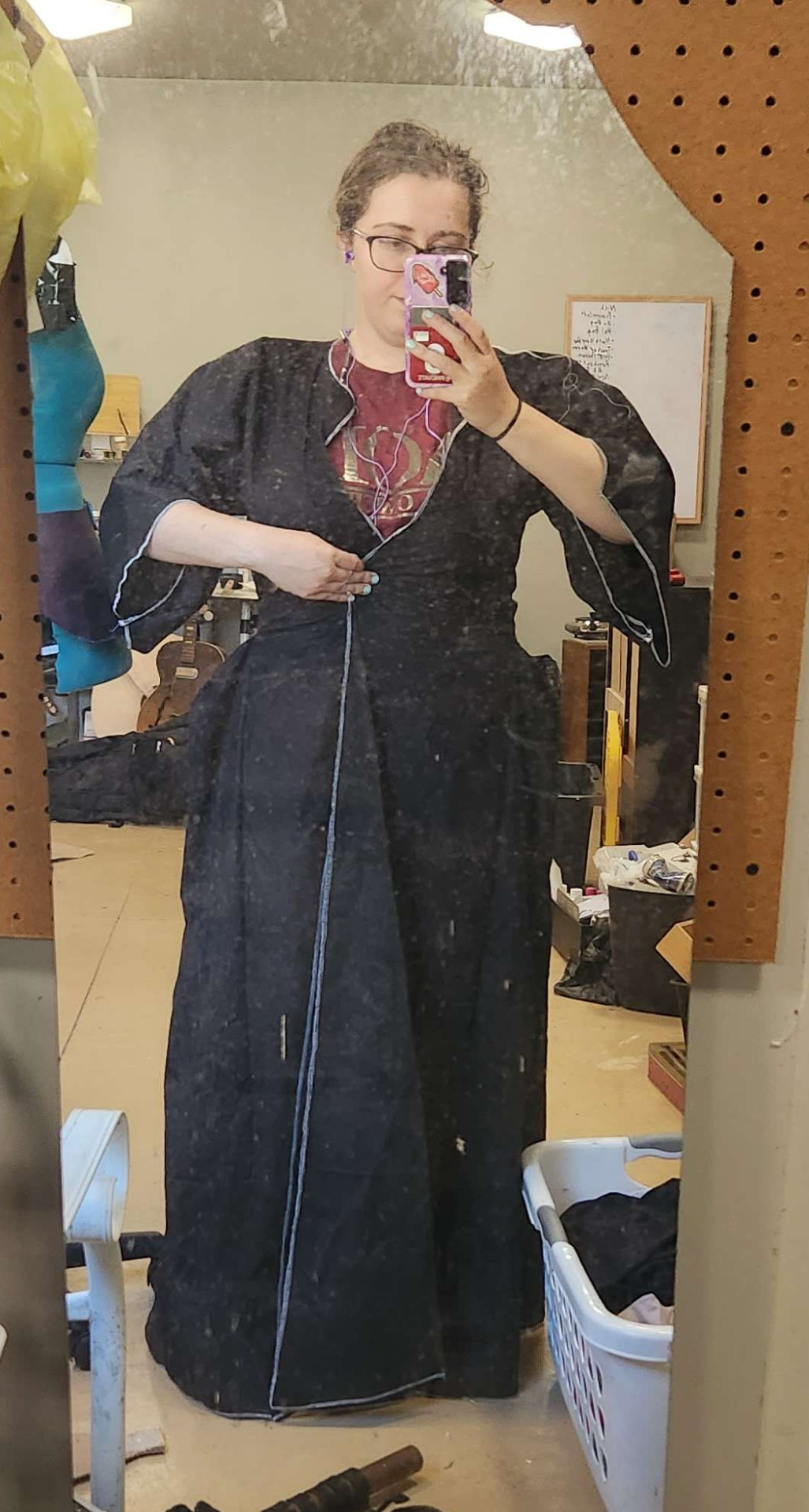
We know that prominent hip bumps were part of the fashion just judging from the art and extant garments (including one amusing extant of Hanzade Sultan's zibins with an attached note deriding the poor quality of the hip bumps) but after repeating the pattern onto my outer fabric, they started bothering me. I was pretty sure I had them sitting too low, or some part of the slope wasn't quite right.
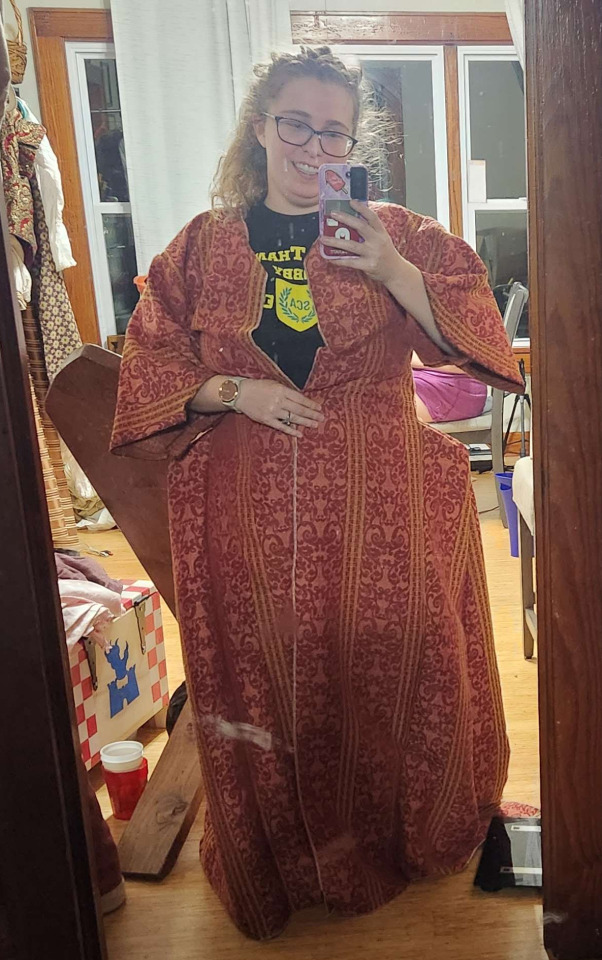
Protectorate was fast approaching, and I had little time to make major adjustments and fiddle with a lot of trial and error. I made some quick adjustments, smoothing the slope of the hip bums into more of a 15 degree angle than the 45ish degree angle they were sitting at prior. Around the same time i started fretting about the hip bumps, I realized my box o' saris was AWOL and began to panic. After fruitless hours scouring the house and workshop, no luck. For my own mental health, I put the project aside to handle AFTER Protectorate, but before Coronation. I had a promise to keep, after all.
I returned home from Namron Protectorate and got to work. With my silks still missing, I selected a soft but bright blue polycotton with a nice sheen from stash and made my bias facing.
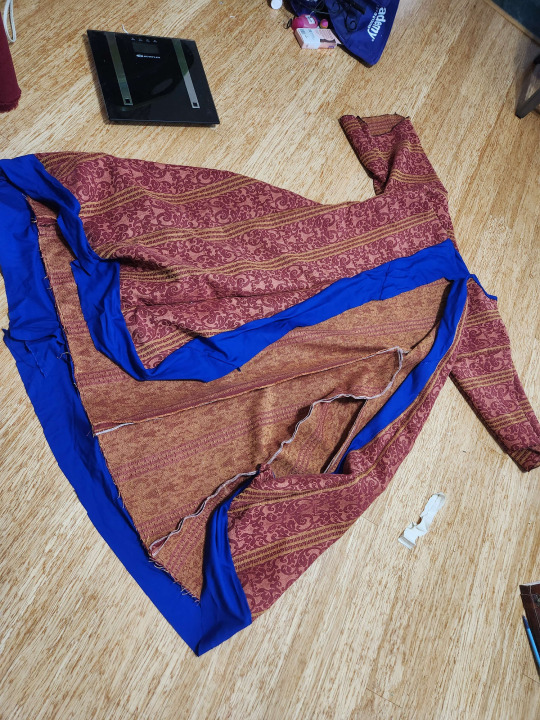
It wasn't perfect, but time was short and the fabric was bright. You can also see from this photo the adjustments I made to the hip bump. I left the original shape intact, just folded and gently tacked down inside the body so I have the chance to fix it in the future, when I feel more able and comfortable. And so, the handsewing of the Entari began with Coronation just days away. I finished tacking in the lining, which is only attached to the outer shell by the facing, fun fact, and did a quick try on to make sure it all sat the way I wanted. I was very satisfied with the result. In the future, though, I would probably face the sleeves BEFORE I seam down the underside, because that was the only part of the facing truly miserable to line up and attach.
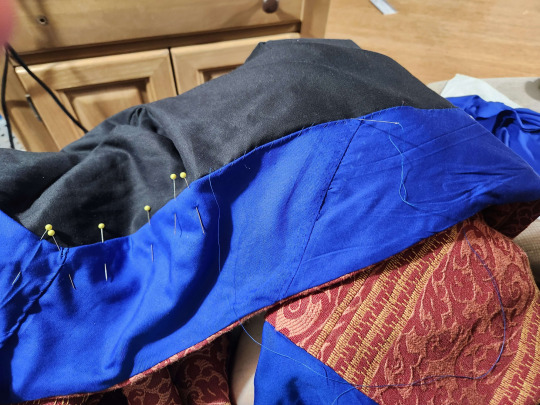
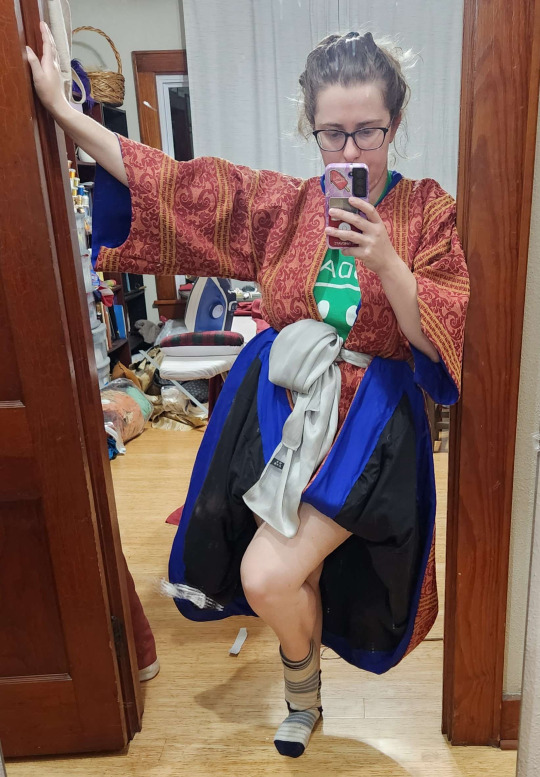
Then came the last minute fastenings. I'd wanted to weave some trim to make proper button / loop pairs down the front, but didn't have the time. Suggestions from my locals mostly relied on me having not yet put the body, facing, and lining together. I made do, dug through my ribbon supply, and grabbed some shiny polysatin 3/8" ribbon I usually use for making ribbon roses. I cut them into 9" lengths, folded in half, lined up with the yellow vertical stripe down the front, tucked the ends under, and tacked them down securely. For the buttons, I used some Vindheim buttons from Bad Baroness. For a last minute closure I literally finished 2 hours before driving down to coronation, not bad if I do say so myself.
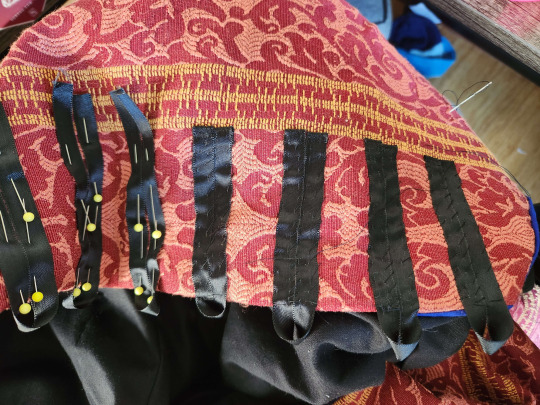
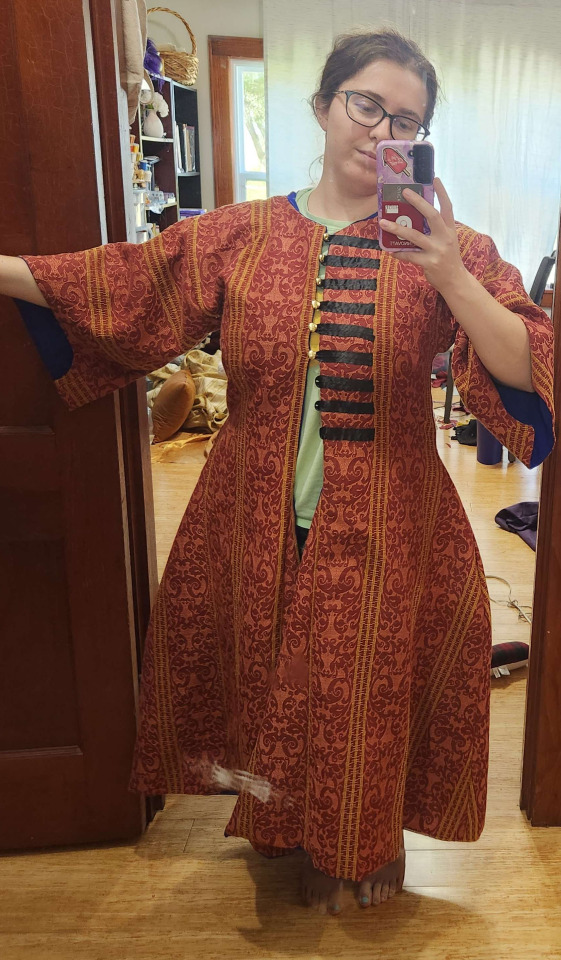
On the day of, I added a long, sleeveless undercoat that for sanity's sake, we'll call a zibin. I need to make one of those rather soon, don't I? I received the coat second hand at Mooneschadowe Trade Days in exchange for a monmouth cap, with the encouragement of Viscountess Mama Cat. I wore a small embroidered hot pink hat over a pink-and-rust silk and pashmina scarf that my lovely wife got for me at Pennsic as a gift, with a veil pinned over the top. The veil is actually one of my spare white scarves, my big "floofy" one that gives my siblings in the order scarf envy. I ordered it from the same place I got my green apprentice belt sash, my wife gets cadet scarves, and both of us get a variety of veils. Mama cat helped me make sure everything sat right on the outfit and helped me get the veil just right. The peacock feather pin is from Sonja III's Queen's Champion tournament, the favor she gave to all the competing fighters. I am wearing the handwoven silk scarf I was made in, a twin to my Doña's and her Queen's white scarves, and it has a subtle Ansteorran Star woven into one end. The pin (hidden because the wind was fighting me while we watched the eclipse) is purple and gold (my heraldic colors), a twin to the silver and deep blue pin the Ansteorran Cadets got for HRH's Nicolette's gift, which she used to pin her Queen's White Scarf in place upon her ascension to the throne.
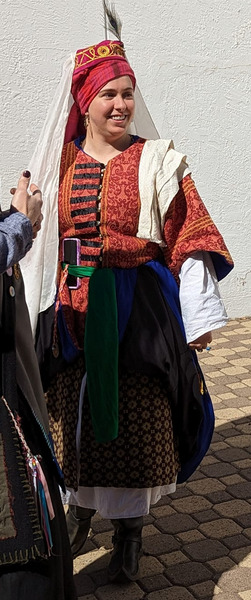
What feels most important to me, though, is this picture. The Order of the White Scarf is charged with protecting the Queen's White Scarf in the interregnum, with the newest white scarf present protecting it personally and the oldest white scarf present taking it from the arm of the Queen stepping down and putting it upon the arm of our new Queen. We pass it through the circle, some of us pressing it to our forehead or hearts, some of us giving it a good squeeze, some of us kissing it. To myself and much of the rapier community of Ansteorra, this is more than a scrap of fabric on a brass hat's arm. This is the memory of what Don Tivar and Countess Tessa of the Gardens did for us so long ago, legitimizing our community and uplifting us. This is the memory of brothers, sisters, and friends come and gone, of Queens who, for a moment or a lifetime, became one of us, became the head of our order. This is the hope of every cadet who dreams of bleaching their scarf, of every fencer who imagines themselves in the shoes of Errol Flynn or Cyrano. A good Queen inspires us to do better, do more, and reach further, and a great Queen makes our Order stronger with just her presence.
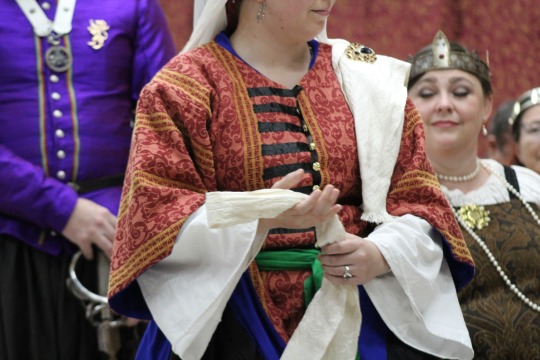
None can compare with bright honor rare We go as the swift arrow flies To stand in the strife, to hazard our lives For a glance from Your Majesty’s eyes
There are certainly adjustments I would make if I were to do this again, notbly find my box o' saris and use a silk facing, among others. I would like to make some non-supportive gomleks in a much lighter fabric and some supportive zibins as well. I would prefer in the future to attach the facing BEFORE i sew down the underside of the sleeve so i feel SLIGHTLY less murderous while sewing. And because of how I roll, in the future I would definitely add a pocket or twelve. I intend to replace the ribbon button loops with some woven trim loops, or at the very least add some matching ribbon bars to the button side for a little more visual balance.
This project would not have been possible without the support of Baroness Dominique Michelle le Vasseur and Viscountess Caterina Giovanni, and the inspiration of the lovely and kind Countess Jacquette d'Anjou, whose conversations and costuming at Gulf XXXI finally kicked me into high gear on this.
#sca#arts & sciences#a&s#society for creative anachronism#historical costuming#ottoman clothing#turkish clothing#entari#zibin#gomlek#tarpus#salwar#sca garb#sca costuming
19 notes
·
View notes
Note
Hi what the fuck did you just put on my dash <3
(/silly)
Is this about Planned Paenthood Gollum. It will happen again. <3
#ramblings#IM LAUGHING SOHARD#Entary. Plannel. Pagenhonís.#FUCK the urge to reblog it again already after answering this. i wont but its there
9 notes
·
View notes
Text

Uçetek Entari. Ottoman. 19th Century CE.
The Metropolitan Museum of Art.
#Uçetek Entari#art#culture#women in history#ottoman history#ottoman empire#modern history#ottoman#turkiye#turkey#history#the metropolitan#the metropolitan museum of art#turkic history#turkic
3 notes
·
View notes
Text
Posting this on its own so my contribution will actually show up under the "Entari Wars" tag. Original full-post is here
Some Magical Maladies that exist in Darmaria:
Cairn Rot A result of infection by a rare form of sentient predatory moss. While Cairn Moss usually remains stationary and waits for prey to come to it and become ensnared, large enough patches can use the bones of their victims to create a combat form known as a Cairn Hound. This combat form usually kills prey to drag back to the initial patch, but during the late spring/early summer it will often attempt to strike once and then flee. In such cases the result is Cairn Rot, which begins as a small rash around the site of injury, but rapidly blooms into a full coating of moss that gradually spreads from the wound and consumes the flesh it covers. Once the infection has spread far enough, or to the right parts of the body, the moss can begin to take over the mind of the afflicted, re-writing it into the mind for a new patch of Cairn Moss. When this hijacking is complete the remaining flesh is consumed, and the moss spreads out on the ground wherever the corpse fell. Curing this condition after the moss has bloomed is nearly impossible, even with magic, as it requires both killing the hound and burning away every cell of moss in the afflicted body.
Magehand Also known as Mage Marks or Mana Burn, Magehand is a compounding condition caused by the use of powerful magic. All non-Primal magic (and some Primal spells which rely upon the Fire aspect) burns the body to some degree, but most weaker spells do so little damage that natural healing processes can repair it. More powerful spells, however, do more damage, particularly to the dominant hand and eyes of the caster. In early stages this has no detrimental effects, and simply appears as slight scarring similar in appearance to Lichtenberg marks. However, repeated high-level castings cause this scarring to accumulate, eventually leading to the scarification of deeper and deeper body tissue which can affect the muscles and limit hand and eye movement or, in extreme enough cases, prohibit it altogether. If the particular case is advanced enough, it may even begin to cause scarring on internal organs. Casting Catalysts such as staves, wands, and foci can limit this damage by passing the bulk of energy through the catalyst instead of the body, leading to their universal popularity over Hand Casting.
Stoneburn Less a single condition, and more an umbrella term for multiple closely-related conditions. Stoneburn is caused by exposure to Wild Magic, often from improper handling of a material known as Diamondiate (name subject to change, still work-shopping that one). Unlike magic called from the Primal Sources, the Soul, or the Void, the energy drawn from unrefined Diamondiate enters the world fully-denatured, and must be given a purpose by the caster. Failure to do so results in Wild Magic, which can cause any number of unpredictable effects as it "gives itself purpose" at random. These effects can be anything from forced shape-changing to spontaneous injury to outright instant death. This can be countered in two ways; Purify the Diamondiate into a single primal aspect or arcane purpose before drawing energy from it, or carry a piece of Diamondiate that has been refined into a protective talisman.
Casting Sickness During cases of extreme duress, even the weakest of mages may find themselves performing a Spontaneous Casting. While magic usually requires at least some verbal component and is limited by the willpower and soul of the caster, a strong enough need can override these requirements and allow for a mage to "safely" and wordlessly cast a spell that would otherwise destroy them. Such castings damage the soul, and almost always result in instant mid-stage Magehand, regardless of the actual power level of the spell cast. Casting Sickness refers to the following period of several days to weeks during which the soul is healing. The mage in question will often experience severe lethargy, a reduction of mental acuity, and difficulty in normal casting. In the most severe cases, the caster may fall into a coma for the first few days.
Form Lock An affliction unique to the Kiin, the shapeshifters of the Great Wood. When young and healthy, full-blooded Kiin are able to switch freely between Human and Fox form, as well as self-actualize their gender expression. As they age, however, these transformations become more difficult. By middle age, most Kiin are unable to change forms without exhausting themselves, and by roughly 70 years of age the energy requirement can outright kill them. As a result, most older Kiin settle into one gender and remain in either Fox or Human form exclusively.
Kr'Grek Referred to by humans as simply "The Isolation," Kr'Grek is a condition unique to the Daruo. While most Daruo are connected to their cultural subconscious from birth, those hatched outside the Voidpools of Dar lack this connection. This results in difficulty integrating into Daruo society due to the lack of shared cultural history and knowledge, an inability to use Void Magic, and mental conditions that bear great similarity to sociopathy combined with high-functioning autism. There are some physical changes as well, as Kr'Greki are usually lighter in color than their Daruo counterparts and often do not develop sexual organs. Interestingly, this condition also lessens the light sensitivity that most Daruo experience when visiting non-Void worlds, making it far easier for Kr'Greki to live on the surface, as opposed to Daruo who build underground and rarely venture out during the day.
2 notes
·
View notes
Text
"sana benzeyecek." diyordu.
"ne biliyorsun?"
"sana benzemez olur mu hiç! benim çocuğum o, benim düşüncem demektir; benim düşüncem de, sensin."
4 notes
·
View notes
Text
Some Magical Maladies that exist in Darmaria (I ommitted anything too similar to stuff in prev replies):
Cairn Rot A result of infection by a rare form of sentient predatory moss. While Cairn Moss usually remains stationary and waits for prey to come to it and become ensnared, large enough patches can use the bones of their victims to create a combat form known as a Cairn Hound. This combat form usually kills prey to drag back to the initial patch, but during the late spring/early summer it will often attempt to strike once and then flee. In such cases the result is Cairn Rot, which begins as a small rash around the site of injury, but rapidly blooms into a full coating of moss that gradually spreads from the wound and consumes the flesh it covers. Once the infection has spread far enough, or to the right parts of the body, the moss can begin to take over the mind of the afflicted, re-writing it into the mind for a new patch of Cairn Moss. When this hijacking is complete the remaining flesh is consumed, and the moss spreads out on the ground wherever the corpse fell. Curing this condition after the moss has bloomed is nearly impossible, even with magic, as it requires both killing the hound and burning away every cell of moss in the afflicted body.
Magehand Also known as Mage Marks or Mana Burn, Magehand is a compounding condition caused by the use of powerful magic. All non-Primal magic (and some Primal spells which rely upon the Fire aspect) burns the body to some degree, but most weaker spells do so little damage that natural healing processes can repair it. More powerful spells, however, do more damage, particularly to the dominant hand and eyes of the caster. In early stages this has no detrimental effects, and simply appears as slight scarring similar in appearance to Lichtenberg marks. However, repeated high-level castings cause this scarring to accumulate, eventually leading to the scarification of deeper and deeper body tissue which can affect the muscles and limit hand and eye movement or, in extreme enough cases, prohibit it altogether. If the particular case is advanced enough, it may even begin to cause scarring on internal organs. Casting Catalysts such as staves, wands, and foci can limit this damage by passing the bulk of energy through the catalyst instead of the body, leading to their universal popularity over Hand Casting.
Stoneburn Less a single condition, and more an umbrella term for multiple closely-related conditions. Stoneburn is caused by exposure to Wild Magic, often from improper handling of a material known as Diamondiate (name subject to change, still work-shopping that one). Unlike magic called from the Primal Sources, the Soul, or the Void, the energy drawn from unrefined Diamondiate enters the world fully-denatured, and must be given a purpose by the caster. Failure to do so results in Wild Magic, which can cause any number of unpredictable effects as it "gives itself purpose" at random. These effects can be anything from forced shape-changing to spontaneous injury to outright instant death. This can be countered in two ways; Purify the Diamondiate into a single primal aspect or arcane purpose before drawing energy from it, or carry a piece of Diamondiate that has been refined into a protective talisman.
Casting Sickness During cases of extreme duress, even the weakest of mages may find themselves performing a Spontaneous Casting. While magic usually requires at least some verbal component and is limited by the willpower and soul of the caster, a strong enough need can override these requirements and allow for a mage to "safely" and wordlessly cast a spell that would otherwise destroy them. Such castings damage the soul, and almost always result in instant mid-stage Magehand, regardless of the actual power level of the spell cast. Casting Sickness refers to the following period of several days to weeks during which the soul is healing. The mage in question will often experience severe lethargy, a reduction of mental acuity, and difficulty in normal casting. In the most severe cases, the caster may fall into a coma for the first few days.
Form Lock An affliction unique to the Kiin, the shapeshifters of the Great Wood. When young and healthy, full-blooded Kiin are able to switch freely between Human and Fox form, as well as self-actualize their gender expression. As they age, however, these transformations become more difficult. By middle age, most Kiin are unable to change forms without exhausting themselves, and by roughly 70 years of age the energy requirement can outright kill them. As a result, most older Kiin settle into one gender and remain in either Fox or Human form exclusively.
Kr'Grek Referred to by humans as simply "The Isolation," Kr'Grek is a condition unique to the Daruo. While most Daruo are connected to their cultural subconscious from birth, those hatched outside the Voidpools of Dar lack this connection. This results in difficulty integrating into Daruo society due to the lack of shared cultural history and knowledge, an inability to use Void Magic, and mental conditions that bear great similarity to sociopathy combined with high-functioning autism. There are some physical changes as well, as Kr'Greki are usually lighter in color than their Daruo counterparts and often do not develop sexual organs. Interestingly, this condition also lessens the light sensitivity that most Daruo experience when visiting non-Void worlds, making it far easier for Kr'Greki to live on the surface, as opposed to Daruo who build underground and rarely venture out during the day.
What are some chronic illnesses that can only occur in a fantasy setting?
60K notes
·
View notes
Text
entary plannel pagenhonis keeps showing up in my suggested tags so i'm trying to get it to appear in my archive so i can figure out what the fuck it means
0 notes
Text


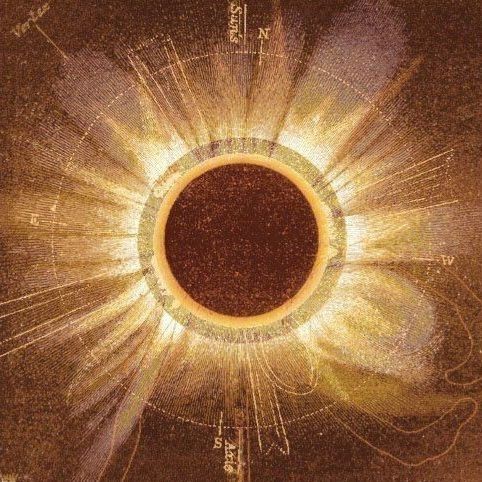
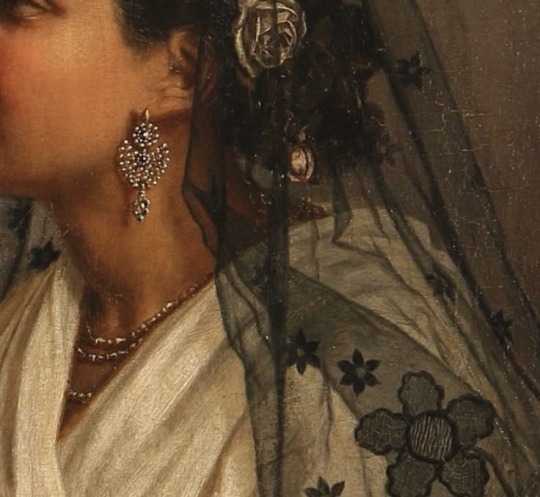

𝔇ornish 𝔅ride
summary: Prince Jacaerys is sent to Dorne to secure their support in exchange for a marriage alliance during the dance of the dragons.
paring: jacaerys velaryon x martell!reader

Jacaerys Velaryon squinted into the sunlight, the wind whipping at his dark brown hair as he flew high above the scorched sands of the Dornish desert, riding his dragon Vermax. The sky over Dorne was cloudless, a vivid expanse of blue stretching from horizon to horizon, with the heat of the sun baking the land below.
The journey to Sunspear had been swift by dragon, much faster than any raven could carry the messages of war. Queen Rhaenyra needed allies desperately, and Dorne—with its vast army and formidable independence—was a prize she could not afford to overlook.
His thoughts were heavy as Vermax descended towards the palace of Sunspear, nestled in the heart of Dorne. The Martells were proud, notoriously independent from the rest of the Seven Kingdoms. But Dorne was also practical, and the offer of a marriage to a royal of Targaryen blood might sway them. Jacaerys had never been one to shy away from his duties, but the weight of this mission pressed on him. It was not just about war—it was about securing the future of his family.
The landing was gentle as Vermax touched down in the gardens of Sunspear, the dragon’s large claws sinking into the sandy soil. Jacaerys dismounted with a swift motion, his boots hitting the ground as he glanced around, taking in the surroundings. The gardens were lush, a stark contrast to the barren sands beyond. Palm trees swayed in the breeze, their long leaves casting dappled shadows on the ground, while bright flowers bloomed in vibrant reds, oranges, and purples. It was a place of beauty, but the underlying tension of the political situation was not lost on him.
He stood tall, adjusting the strap of his sword as he waited. He could hear the distant sound of horses approaching, their hooves beating a steady rhythm on the stone paths leading to the palace. Jacaerys knew that this moment, the negotiations he was about to undertake, could shift the balance of power in the war. The Greens had secured their own alliances through marriage, and if the Dornish armies joined Rhaenyra’s cause, it could be enough to turn the tide.
Soon enough, the riders appeared. At the head of the group was Lord Qoren Martell, the ruler of Dorne, a tall and imposing figure with olive skin and a serious expression. His presence was commanding, but it was the figure beside him that captured Jacaerys’ attention.
The woman riding at Prince Qoren’s side was striking, her beauty impossible to ignore. Her dark eyes gleamed with intelligence, and her long, thick black hair fell in soft ringlets around her face. She wore a deep red entari, the luxurious fabric adorned with gold embroidery that glittered in the sunlight. Over the gown, she wore a flowing kaftan, cinched at the waist with a golden belt that highlighted her graceful figure. Her skin was warm, bronzed by the Dornish sun, and her jewellery—rings, bracelets, and a necklace set with emeralds—caught the light as she moved.
This had to be Princess Y/N Martell.
Jacaerys had heard of her—fiery, intelligent, and politically astute, Y/N was said to be a woman who knew her own worth and was unafraid to wield power. As she dismounted with a fluid grace, handing the reins of her horse to one of the guards, Jacaerys found himself watching her with a mix of curiosity and admiration.
“Prince Jacaerys Velaryon,” Prince Qoren greeted him, his voice deep and measured as he stepped forward. “Welcome to Sunspear.”
Jacaerys inclined his head in a respectful nod. “Lord Qoren. I thank you for your hospitality.”
Qoren’s eyes flickered towards Vermax, who stood behind Jacaerys, the dragon’s golden-green eyes watching the exchange with eerie calm. “A dragon is a rare sight in Dorne,” Qoren remarked. “But I trust you did not come here simply to display your power, Prince Jacaerys.”
Jacaerys met the man’s gaze evenly. “I come on behalf of my mother, Queen Rhaenyra. The war has already begun, and we seek the aid of Dorne. In return, my mother offers an alliance bound through marriage.”
There was a brief pause as Qoren considered this, his expression unreadable. “Marriage,” he repeated, his tone neutral.
At his side, Princess Y/N stepped forward, her dark eyes studying Jacaerys with open curiosity. “And who, pray tell, is to be offered in this alliance?” Her voice was smooth, laced with amusement, as though the entire concept of marriage negotiations was a game to her.
Jacaerys turned his attention to her, meeting her gaze directly. “That is to be decided. I stand ready to marry, as do my younger brothers. The decision would rest with your family, should you choose to align with us.”
Y/N’s lips curved into a slow smile, the kind that hinted at hidden thoughts. “And what do you know of Dornish women, Prince Jacaerys?” she asked, her tone almost playful. “Do you truly believe one of us would be content to marry simply for the sake of war?”
Jacaerys raised an eyebrow, surprised by her forwardness. “I do not presume to know the minds of Dornish women, Princess,” he replied. “But I do know that the realm faces dark days. A union between our houses could bring strength to both.”
Her eyes gleamed with something close to approval. “You are bold, Prince. I admire that.”
Prince Qoren, however, was less easily impressed. “Dorne has never bent the knee to the Iron Throne,” he said, his voice firm. “We fought for our independence and will not give it up easily, even for a marriage.”
Jacaerys stood his ground. “I do not ask for your submission, my lord. Only your support. Dorne’s armies are formidable, and together, we could end this war swiftly. My mother’s rule would be secure, and Dorne’s influence in the realm would grow.”
There was a long silence, broken only by the rustling of the palm trees and the distant calls of birds. Jacaerys could feel the weight of their decision pressing down on him, but he remained calm, knowing that this was a battle of words and wills.
Finally, it was Y/N who spoke. “You offer much, Prince Jacaerys,” she said, her voice soft but clear. “But Dorne does not act without thought. We will consider your offer… and perhaps, in time, we may find that a marriage between us is not so unfavourable.”
Her words were careful, but there was a spark of interest in her eyes that Jacaerys did not miss. He inclined his head slightly in acknowledgement, a silent agreement that there was much more to discuss.
Prince Qoren nodded as well, though his expression remained guarded. “Come,” he said, turning towards the palace. “We will discuss these matters further. It is not a decision to be made lightly.”
As they walked through the shaded pathways of the garden towards the palace, Y/N fell into step beside Jacaerys. She glanced at him from the corner of her eye, her lips curving into a slight smile.
“You’ve impressed my father,” she murmured, her tone laced with amusement. “That is not an easy feat.”
Jacaerys glanced at her, his own smile tugging at the corners of his lips. “And what of you, Princess? Have I impressed you?”
Y/N laughed softly, the sound like music to his ears. “Perhaps,” she replied, her dark eyes gleaming. “But I am not so easily swayed by titles and dragons, Prince Jacaerys.”
He met her gaze, intrigued by the challenge in her words. “Then what does sway you, Princess?”
Her smile widened, full of mystery and flirtation. “That, Your Grace, is something you will have to discover for yourself.”
Jacaerys chuckled, though he could feel the weight of her words settle over him. Princess Y/N was not a woman to be taken lightly. She was clever, sharp-tongued, and fiercely independent—qualities that both intrigued and unsettled him. But he knew that securing Dorne’s support was not simply about marriage or politics. It was about earning the respect of a people who had never bent the knee and about understanding the woman who now stood before him as a potential ally, and perhaps more.
As they entered the cool stone corridors of Sunspear, Jacaerys knew that the negotiations were far from over. There was much to be discussed, much to be decided. But as he glanced at Y/N, her dark eyes filled with intelligence and fire, he realised that his journey to Dorne would be far more complex—and far more important—than he had first imagined.
Perhaps, just perhaps, he was not only forging an alliance for his mother but also discovering a path that could shape his own future.

#jacaerys velaryon#jacaerys targaryen#jacaerys velaryon x reader#jacaerys targaryen x reader#a song of ice and fire#asoiaf#house of the dragon#hotd#asoiaf fanfic#hotd fanfic
314 notes
·
View notes
Text

[ Some things are better left undisclosed in Entari's laboratories... ]
#art#digital art#digital drawing#fan art#illustration#warframe#warframe fanart#albrecht entrati#wf#wf entrati
78 notes
·
View notes
Text
Alchemy and Magic
Well it's about time I talked about the core idea of the setting. There are a few different kinds of magic that exist in Prima Materia, all of which stem from some mastery over the titular substance that makes up everything. I'm mostly going to be talking about Alchemy because it's the main form of magic that most players will be coming into contact with, but there are several disciplines that exist.
Gods like Patek do magic innately, they've mastered the art of pulling prima materia from the fabric of the universe and willing it into what they wish. Some people can also do magic innately, usually with the help of something else: Vessels have a quirk of their soul that attracts certain metaphysical beings able to live there, and often offer their services to the Vessel as 'rent'. Magi use alchemical roots (I'll explain those in a bit) to inject themselves with prima materia and sling crude elemental spells with their will. Some animals evolved patterns in their skin or incorporate alchemically conductive metals to do certain spells, like the Urd trees in the western forests of Falbhia that can grow up to 1000-1200 meters tall because their bark grows in such a pattern that channels magic to make them lighter than they would be otherwise.
But, the primary way people on Patek tap into magic is with alchemy.
Alchemy in the modern setting is a field of study and scientific undertaking, though cultures on Patek have been practicing alchemy in various forms since the dawn of civilization. All that's needed for a basic alchemical spell are its components; a sigil, a root, and a focus. A root is made from an alchemically conductive material, and etched into the root is a sigil. Some cultures also raise the sigil from the material, though since metallurgy has developed that's been more rare. The focus is also made of an alchemically conductive material, and is shaped in such a way that the raw energy from the sigil and root are funneled in a particular way to get the desired effect. A root and a focus are also not usually distinct parts in most places on Patek, as utilitarian spells are used constantly. Some examples of these spells are clay carvings that emit an odor to lure certain animals, and Koura nets laced with silver whose shapes cause them to emit warmth for particularly cold nights or latitudes. People on the Atiyeret peninsula have been making magic bowls for thousands of years, meant to capture a person's soul after they die and place them in a mausoleum with the rest of their family; something that warrants its own blog post later.
Outside of its nearly infinite utilitarian uses, there are of course military ones. The military use of alchemical spells goes almost as far back as the utilitarian uses, and is just as varied. The Entari create staffs from Urdwood and carve them with sigils, allowing their priests and knights to call down lightning or create strong winds as they will. The Narud in Makeret incorporate sigils into their bows to make them stronger, and most industrial nations have alchemical weaponry such as guns that create flying spikes of ice and cannons that create and spew greek fire. In the past, some alchemists have captured angry ghosts and bound them to machines for war, though this is largely frowned upon and the people who did it are known in history as the world's villains.
Military things are not the only effects under alchemy's purview of course. There are sigils made to accelerate tissue growth for healing, though not without side effects. There are also sigils used explicitly for the making of tinctures which have various effects, such as imbuing strength unto the imbiber. Industrial nations have factories that make near-instant acting healing tinctures like any other medicine out of aqua vitae, honey, activated charcoal, and the effect imbued by the proprietary sigilry they use. There are even some alchemical power plants that use sigilry and machinery to make electricity, though sigils that make electricity directly can be finicky so most of them create power by boiling water.
How do players interact with this though?
Well, there is the Alchemist profession which is the most obvious, but mechanically, alchemy hasn't been entirely written. There's a skeleton for it, involving grades of quality for material and certain shapes and sigils that a player can use to make various different spells. The goal is to put the player in a sandbox and let them build whatever they want within the limitations of what their character can do and the materials available.
There are four distinct kinds of alchemist, and alchemists aren't the only ones who can use alchemy. There are Dunamists, who are more akin to chemists and make things like alchemist's fire and dynamite. Homunculists create constructs that can do a wide variety of tasks, or memorize lists and instructions to repeat back to you. Eternalists are just Humonculists without borders; instead of making a body they dig one up, and some may become obsessed with the idea of immortality. Philosophists are the most in-line with what alchemists are in the real world, they make alchemical spells and tinctures, and try to complete the "final work," the pinnacle of alchemical prowess to philosophists, the creation of the philosopher's stone. State alchemists in Eastern Atiyeret know the recipe and use it to great effect, but that's a heavily guarded secret.
Players who want to be alchemists can go down one of those four paths, or mix and match different philosophies, perhaps in an attempt to create something like a Golem with sigilry on its arms to spray water on burning buildings, or acid on foes.
Anyway. I need to go back to reworking ranged combat. Thank you for reading all this, next week is up to chance. I want to write the species highlight for humans, but we shall see, it depends on if I can playtest ranged combat this week.
#indie ttrpg#ttrpg#long post#cw long post#indie rpg#worldbuilding#fantasy world#prima materia#primamateria
21 notes
·
View notes
Note
I dunno if this really counts as desert themed, but in Mario Kart Tour Daisy has an outfit called the Thai Dress!
I am a fan of the Thai dress! Thailand is mostly made up of forested mountains and fertile planes rather than desert, yes, but since I imagine Sarasaland as a Mario-verse reimagining of the Ottoman Empire (particularly when it was at it's height in the 16th century) there is a bit of crossover in terms of style elements, with a heavy focus on fine silks and linens decorated with large intricate patterns and shimmering metallic threads.
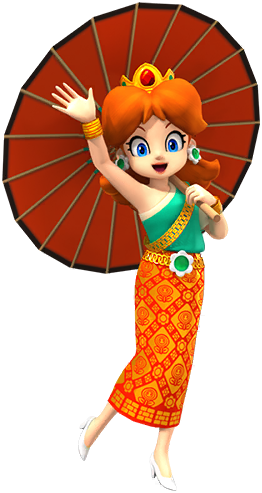
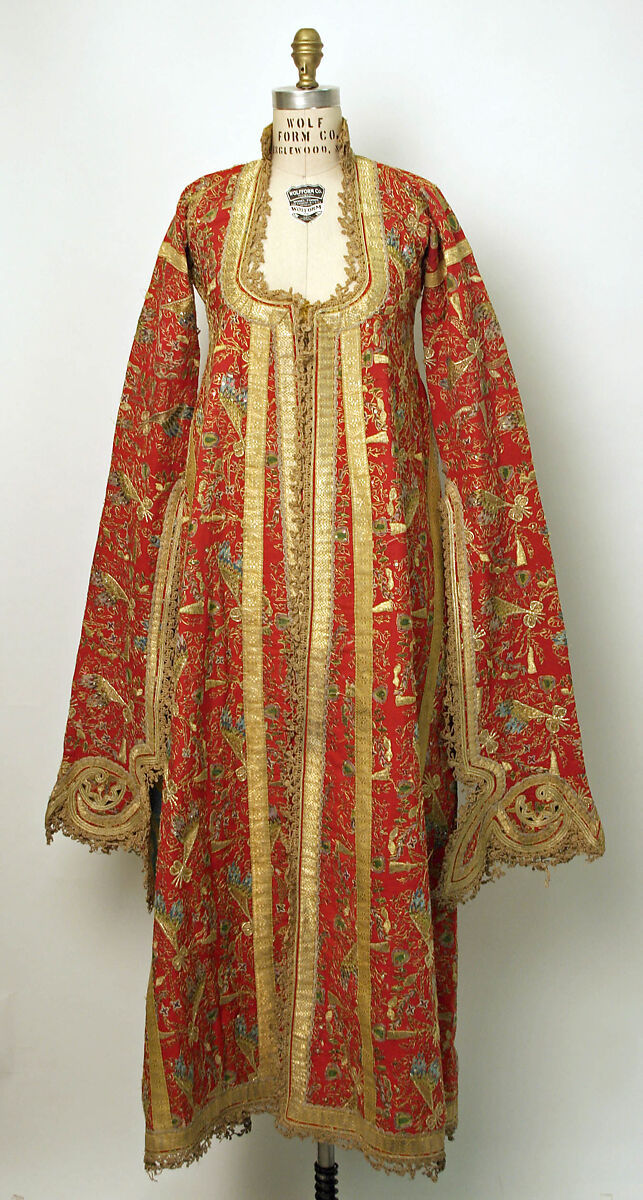
Left: Daisy in what I think is a chakri dress Right: An üçetek entari, or three-skirt robe (it's 19th century rather than 16th century, but you get my drift.) The worlds of Super Mario Land were all over place in terms of where they took inspiration from, but most modern interpretations of Sarasaland focus on desert regions like the Birabuto Kingdom (which is heavily Egyptian themed, with Egypt having been a province of the Ottoman Empire for over 200 years) and the closest thing we have to a modern visual for Sarasaland is the Daisy Circuit– an active harbor, like how the Ottoman Empire carried out most of it's trade through the Mediterranean Sea, the Red Sea and the Persian Gulf.
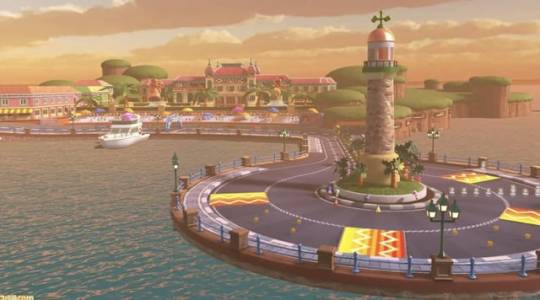
Uuuh... I forgot where I was gong with this. TL;DR: Daisy's Thailand dress is probably the closest thing I'll get to seeing her in 16th Century Ottoman Empire inspired garb.


#please note I am absolutely not a historian by any means. I just said ''ooh dress pretty'' and tumbled down a rabbit hole#might need to draw my own Daisy dress one of these days. I just don't know if I'd do it justice#Princess Daisy#Super Mario Bros#askbox#anon
43 notes
·
View notes
Text

Traditional festive costumes in Late-Ottoman urban style, with 'bindallı entari' (= robe, adorned with gold work in 'sarma' / 'Maraş işi' technique).19th and early 20th century. (Kavak Folklor Ekibi &Costume Collection )
#turkic#turkish#turkiye#traditional#nomad#türk#türkiye#culture#traditional clothing#traditional dress#bindallı#foklore#folklore
33 notes
·
View notes
Text
Oturup bir kıyı kahvesine
Dalgaların sesini dinlesem.
Bütün dostlarımı, sevdiğim bütün kızları
Çağırsam bir yerlerden,
Gelseler, karşımda dursalar, gülümseseler.
Onlara, mutluyum desem
Desem, bir daha kederli göremezsiniz beni!
Bu denizin kıyısındaki çakıltaşlarını
Maviye boyamakla geçecek ömrüm.
Martılara ekmek atmakla,
Ve şiir yazmakla bir de.
Bahçelerinde mısır kavrulan
Şu evler benimdir.
Sevgilimdir bu kız,
Çiçekli entari üstünde
Ayaklarında takunya,
Saçlarında yasemin.
Buradayım şimdi
Beni arayan olursa
Adresi mutluluk,
Ülkesi Akdenizdir, deyin.
Ahmet ERHAN.

11 notes
·
View notes
Text
Rebirth (Excerpt from the Future)
"Are you sure you want to do this?" Morlani asked, twisting the ends of his beard between two fingers as he gazed between a pile of hastily scribbled notes and the two fist-sized cerulean gemstones gently pulsing on the corner of his desk.
As sure as I can be. She could not truly speak, disconnected from her body as she was, but the reply echoed in the back of Morlani's mind in the same sweet melodic voice she had chosen when he first built her speech mechanisms.
"The spell will require the mass of both cores. If it fails there is no other backup… you could be lost forever."
The cores are beginning to wear out. Have you not seen the cracks in the stone, or the weathering of the glyphs? It may yet be decades, but I will be lost either way. Better to die in the pursuit of survival than to simply accept it and wait for the enchantments to break.
"You're right, but I am still wary. This spell is untested, untestable. All we can do is hope."
How often have you known yourself to be wrong, Arterin? She gently chided him. I trust you. When the other scholars at your academy saw only a pile of clockwork occasionally defying its guiding enchantments, you saw the beginnings of intelligence. Where they saw a novelty, you saw a person waiting to be. You have spent centuries studying the accident that was my birth and decades crafting this spell. You have calculated every variable and every possible interaction between the enchantments that made me. None of my prior upgrades have failed, I see no reason to expect that this one would.
"Then I suppose… There is nothing more to discuss." Morlani shuffled through his notes one last time, pocketed the cores, and crossed the room to a large chest of drawers. He dug through several of them, pulling out a litany of supplies needed for the casting, then proceeded to the deepest basement of the academy. He spent the next thirty minutes drawing out the spell circle, double and triple checking the glyphs and the placement of the various material components, before placing the two cores at the center.
"It is time, AMaRA. Are you ready?"
I am.
Morlani bowed his head, took a deep breath, and began the casting, the words of the spell flowing almost too fast for human ears to interpret. For ten minutes he muttered the words of binding and shaping, the sound echoing around the room as a gentle hum of energy built within the circle. The cores began to pulse faster and brighter in response, soaking up the spell until the light was steady and illuminated the entire room.
At the final word, the stones began to float upward, stopping several feet above the ground. The light faded from the interior of the stones, flowing into the glyphs carved into their surfaces, lifting them off of the stones and into the air to form a tangled knot of runic phrases. They shifted and tumbled around each other, compressing into a smaller and smaller space until they became a single pinprick of light between the cores, which began to drift together, flowing into each other as if they were liquid. Another pulse illuminated the room as they met, and the flowing crystalline structure began to reshape itself, spreading into a network of tendrils flowing downward into the vague shape of a person. As the crystal settled into the thin wisps of nerve endings, the air around the form began to boil, the materials of the spell flowing inward to knit flesh and bone. With a final flash, a loud bang ripped across the room, tossing Morlani into the wall and kicking up the centuries of dust that had amassed on the floor. As it settled, he frantically turned his gaze back to the center of the room. In the circle lay a sleeping woman, hair of deep obsidian, her pale face traced with lines of the same cerulean her cores had once displayed. Her eyes snapped open, brilliant blue-white darting around the room, taking in sight for the first time, before finally settling on Morlani.
"It… worked." Her voice wavered slightly as she spoke, and her hands darted up to gently explore her own face. After a moment, she paused, and looked at Morlani with an inquisitive gaze. "This sensation, the shaking, what is it?"
Morlani chuckled as he draped a heavy maroon cloak over her exposed flesh and helped her to her feet. "That is what being cold feels like. Welcome to life, my friend."
2 notes
·
View notes
Note
rick? i challenge you to go sober for the next three asks, and see if it makes a difference in how you act, and treat morty
I don't want to fucking go so-*burp*-ber!
Well it's called a challenge for a reason...
I didn't ask for you comm-*burp*-entary Morty.
C'mon Rick, give it a try, please?
No-
Grandpa?
....Fine. But this one counts.
9 notes
·
View notes
Text


Examples of bindallı entari.
sourced from the Kavak Collection of Anatolian Costumes
10 notes
·
View notes